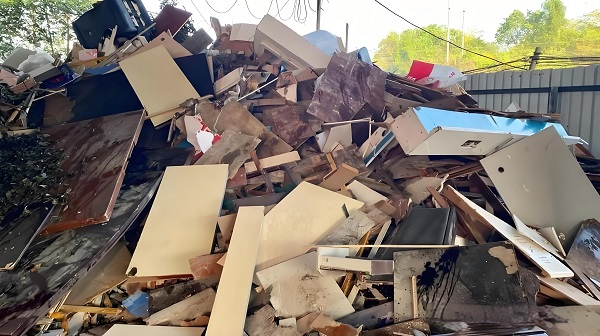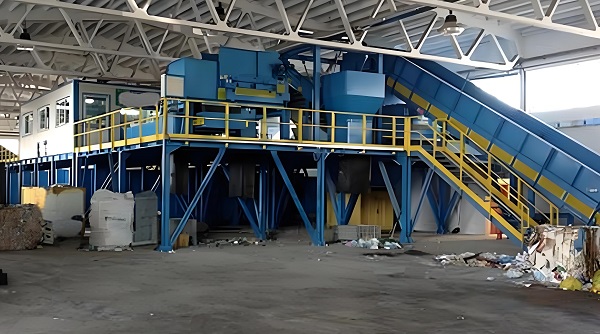The bulky waste disposal system is specially used to deal with waste that is large in size and difficult to be handled by conventional garbage disposal methods, such as furniture, household appliances, construction waste, etc. The system usually includes crushing, sorting, recycling and disposal. First, the large-scale garbage is crushed by a crusher to reduce the volume; then, recyclable materials such as metals, plastics, and wood are separated by sorting equipment for resource utilization; finally, the remaining non-recyclable parts are harmlessly treated, such as incineration or landfill. This system not only improves the efficiency of garbage disposal, but also promotes resource recovery and environmental protection, and reduces the burden of garbage on the environment.

Bulky waste
The process flow and technology of the bulky waste disposal system are introduced as follows:
A. Process flow
1. Collection and transportation
Residents put in: Residents place large-scale garbage that they no longer need at designated locations, such as large-scale garbage collection points in the community.
Centralized collection and transportation: Professionals regularly collect and transport these large-scale garbage to the garbage sorting center.
2. Pretreatment
Loading: Before large-scale garbage is sent to the crusher, it is first loaded by equipment such as chain conveyors.
Crushing and volume reduction
Crushing: Use equipment such as a double-axis shearing crusher to crush large pieces of garbage to reduce their volume for subsequent processing. This step usually includes primary crushing and secondary crushing. The primary crushing will initially crush large pieces of garbage, and the secondary crushing will crush the materials to smaller particles to meet the requirements of resource utilization.
3. Sorting
Magnetic separation: Magnetic separation is used to remove ferromagnetic debris from garbage to prepare for subsequent recycling of resources. At the same time, the sorted ferromagnetic waste can also be sold as a partial economic source.
Wind separation: Use wind power to separate crushed materials of different densities to further purify resources. Mainly sort combustible materials such as plastics and paper.
Photoelectric sorting: Use photoelectric sorting technology to accurately classify different materials to improve the recycling rate of resources.
4. Resource utilization
Metal recovery: The separated metal substances are recycled and sent to metallurgical plants for reuse.
Wood processing: Wood can be processed into recycled wood products or used for biomass energy.
Plastic recycling: Plastics are melted and recycled into new plastic products.
Fabric processing: Fabrics can be processed into recycled cotton or other textiles.
RDF molding: Combustibles are processed into high calorific value fuel rods, which can be used to replace traditional fuels.

Bulky waste disposal system
5. Final treatment
Incineration power generation: Non-recyclable organic matter and other materials not suitable for landfill can be sent to the waste incineration plant for incineration power generation.
Safe landfill: For those residual materials that cannot be recycled, they are safely landfilled.
B. Technical introduction
1. Crushing technology
Double-axis shearing crusher: Suitable for the initial crushing of large pieces of garbage, with the advantages of high crushing efficiency, low noise and smooth operation.
Single-axis fine crusher: Used for secondary crushing, crushing materials to smaller particle sizes to meet the requirements of resource utilization.
2. Sorting technology
Magnetic separation technology: Separate ferromagnetic debris from garbage through magnetic force, with the advantages of high separation efficiency and simple operation.
Wind selection technology: Use wind power to separate materials of different densities, suitable for separating combustibles and heavy materials.
Photoelectric sorting technology: Photoelectric sensors are used to identify and classify different materials, with the advantages of high sorting accuracy and high degree of automation.

Waste disposal system
3. Intelligent management technology
Intelligent control system: Equipped with automated control systems and intelligent systems to achieve digital management, improve production efficiency, and reduce operating costs.
Remote monitoring and fault diagnosis: The remote monitoring system monitors the operating status of the equipment in real time, detects and handles faults in a timely manner, and ensures stable operation of the equipment.
PS: The bulky waste disposal system realizes the resource utilization and reduction of large-scale garbage through a series of process flows and technical means, which helps to reduce environmental pollution and resource waste and promote sustainable development.
Save Time! Get A Detailed Quotation Quickly.
